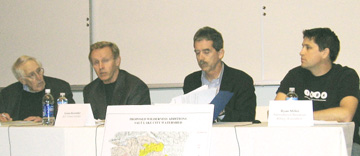Wasatch Front Forum:Wasatch Wilderness
Panel Discussion
Tracie Kirkham
February 20, 2007
|
Gale Dick explained Save Our Canyon’s position was to greatly expand the wilderness areas along the Wasatch Front. He posed four questions that he thought must be answered to determine if certain lands are appropriate for wilderness designation: 1.) What is the problem? 2.) What is to save? 3.) Why wilderness designation is part of the solution? and 4.) What are the chances?
He discussed how the increasing population growth puts tremendous pressure on our canyons and open spaces. Protection of Salt Lake City’s watershed areas used for culinary drinking water and wildlife habitat are two great examples of what needs to be saved. The recreation opportunities that we enjoy in such close proximity to our large metropolitan area will cause detrimental effects, overuse and degradation of the forest and the watershed areas if protections are not implemented.
“Wilderness designation, which can only be enacted through Congress, is the highest protection to public land resources by the Federal Government and can only be reversed by Congress,” said Dick. There hasn’t been a new wilderness designation for the past 23 years on the Wasatch Front. If there will be further consideration and discussion for wilderness in Utah, the time is now. With changes in the political climate in Washington, Save Our Canyons is hopeful that Wasatch Wilderness will again be brought to the table. Dick stated, “Wilderness cannot control the number of people, but it can regulate the impacts on the land.”
Mr. Kroenke’s point of emphasis was on the “Forest Plan.” The Forest Plan is a document which provides management prescriptions of individual National Forests, in this case, the Wasatch-Cache National Forest. The National Forest lands are inventoried, and then within the Forest Plan, areas of wilderness designation are recommended. But as mentioned before, only Congress has the power to designate wilderness. There are many different stakeholders and opinions when public lands are discussed for potential wilderness designation. Compromise will be a key element with all stakeholders regarding any protections on public lands.
Salt Lake City representative Jeff Niermeyer voiced Public Utilities’ long history of watershed protection in partnership with the U.S. Forest Service. Starting in 1914 and in 1934, Congressional Acts were passed to protect watersheds supplying water to Salt Lake City. These watershed areas include City Creek, Parleys Canyon, Big and Little Cottonwood Canyons. Niermeyer’s perspective is that federal wilderness designation is one of the most effective management actions to protect Salt Lake City’s culinary watersheds. He stated politics can play a big role in the wilderness dialogue. In 1999, Salt Lake City approached Utah politicians regarding the topic of wilderness. It was very apparent the rights of private in-holdings, private corporations, such as ski resorts, helicopter skiing, and other stakeholders play an important role in the wilderness dialogue. Again, the word “compromise” was emphasized.
Ryan Miller of IMBA acknowledge that in 1964, when the Wilderness Act was written, mountain biking wasn’t considered a recreational activity. He mentioned his organization would like to see biking included as a recreational activity as defined in the Wilderness Act, but he admitted with a smile, that action was unlikely. He would like to see certain canyon lands left open for the mountain biking community to enjoy.
There were several questions from the audience ranging from impacts of different types of recreational user groups, water supply, and definitions of “mechanized uses.” For example, bikes are defined as mechanized and are thus not allowed in the wilderness areas, however the same argument could be made related to Telemark ski gear, which is allowed in designated wilderness areas. These concepts and questions were discussed by the panel with no clear consensus.
Mr. Kroenke noted that the Forest Service tries to manage public lands in such a way that creates a balance for a large range of recreational experiences.
Mr. Niermeyer answered a question regarding the future water supply in light of potential impacts of global warming. Additionally, he spoke out against a re-visited concept of proposed tunnels in our Watershed canyons between Little Cottonwood, Big Cottonwood, and Park City. The “tunnels” idea was brought out the 1980’s, but with true conviction for watershed protection, was defeated. It was his opinion that if the proposed tunnels were to become a reality, there would be little to stand in the way of expansive development in the watershed canyons. Development is perceived as a great loss in the goal of maintaining the excellent water quality that has been enjoyed by Salt Lake City and County residents for over the 100 years.
In summary, the discussion allowed the audience to understand in greater detail the perspective of each panelist concerning wilderness designation of public lands. Balancing the needs of all potential stakeholders in public land management from private individuals and organizations to public agencies will require a spirit of compromise.
